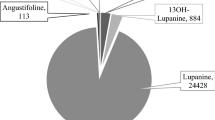Abstract
The sesquiterpene lactone parthenin, one of the major toxins in an obnoxious weed, parthenium (Parthenium hysterophorus L.), was toxic at 50 ppm to the floating aquatic weeds pistia (Pistia stratiotes L.) and lemna (Lemna pausicostata Hegelm.) and at 100 ppm to water hyacinth (Eichhornia crassipes Mart Solmns.), salvinia (Salvinia molesta Mitchell), azolla (Azolla nilotica Decne.), and spirodella (Spirodella polyrhiza L. Schleid). The lethal dose for the submerged weeds najas (Najas graminea Del.), ceratophyllun (Ceratophyllum demersun L.), and hydrilla (Hydrilla verticillata L. f. Royle) was 25 ppm. The submerged aquatic weeds were more sensitive to parthenin. Water hyacinth was used as a representative for studying the phytotoxicity of parthenin on aquatic weeds. Inhibition of water hyacinth by parthenin was associated with decline in water use, root dysfunction, excessive leakage of solutes from roots indicative of massive damage to cellular membranes, loss of dehydrogenase activity in the roots, and loss of chlorophyll in the leaves. Plant death occurred in a period of one to two weeks. Parthenin phytotoxicity is gradually lost in an aquatic environment as a lethal dose became nonlethal in about 30 days under outdoor conditions. Possible buildup of a toxin concentration may affect population dynamics and a shift in the aquatic weed flora in the immediate area of parthenium stands. Accumulation of the toxin in an aquatic environment, however, at a level sufficient to produce such changes in a natural ecosystem as a consequence of rain washing parthenium plants and leaching of toxin from their residue appears to be unlikely.
Similar content being viewed by others
References
Arnon, D.I. 1949. Copper enzymes in isolated chloroplast. Polyphenol oxidase inBeta vulgaris.Plant Physiol. 24:1–15.
Chefurka, W. 1978. Sesquiterpene juvenile hormones: Novel uncouplers of oxidative phosphorylation.Biochem. Biophys. Res. Commun. 83:571–578.
Fisher, N.H., Williamson, G.B., Weidenhamer, J.D., andRichardson, D.R. 1994. In search of allelopathy in the Florida scrub—the role of terpenoids.J. Chem. Ecol. 20:1355–1380.
Jain, R., Singh, M., andDezman, D.J. 1989. Qualitative and quantitative characterization of phenolic compounds from lantana (Lantana camara) leaves.Weed Sci. 37:302–307.
Kanchan, S.D., andJayachandra, P. 1980. Allelopathic effects ofParthenium hysterophorus L. IV. Identification of inhibitors.Plant Soil 55:67–75.
Pandey, D.K. 1994a. Inhibition of salvinia (Salvinia molesta Mitchell) by parthenium (Parthenium hysterophorus L.). I. Effect of leaf residue and allelochemicals.J. Chem. Ecol. 20:3111–3122.
Pandey, D.K. 1994b. Inhibition of salvinia (Salvinia molesta Mitchell) by parthenium (Parthenium hysterophorus L.). II. Relative effect of flower, leaf, stem, and root residue on salvinia and paddy.J. Chem. Ecol. 20:3123–3131.
Pandey, D.K., Kauraw, L.P., andBhan, V.M. 1993a. Inhibitory effect of parthenium (Parthenium hysterophorus L.) residue on growth of water hyacinth (Eichhornia crassipes Mart Solms.). I. Effect of leaf residue.J. Chem. Ecol. 19:2651–2662.
Pandey, D.K., Kauraw, L. P., andBhan, V.M. 1993b. Inhibitory effect of parthenium (Parthenium hysterophorus L.) residue on growth of water hyacinth (Eichhornia crassipes Mart Solms.). II. Relative effect of flower, leaf, stem, and root residue.J. Chem. Ecol. 19:2663–2670.
Picman, A.K. 1986. Biological activities of sesquiterpene lactones.Biochem. Syst. Ecol. 14: 255–281.
Picman, A.K., Towers, G.H.N., andSubbarao, P.V. 1980. Coronopilin—another major sesquiterpene lactone inParthenium hysterophorus.Phytochemistry 19:2206–2207.
Towers, G.H.N., Mitchell, J.C., Rodriguez, B., Bennett, F.D., andSubbarao, P.V. 1977. Biology and chemistry ofParthenium hysterophorus L., a problem weed in India.J. Sci. Ind. Res. 36:672–684.
Author information
Authors and Affiliations
Additional information
A portion of this work was presented at the XVI International Congress of Biochemistry and Molecular Biology held at New Delhi, from September 19–22, 1994.
Rights and permissions
About this article
Cite this article
Pandey, D.K. Phytotoxicity of sesquiterpene lactone parthenin on aquatic weeds. J Chem Ecol 22, 151–160 (1996). https://doi.org/10.1007/BF02040206
Accepted:
Issue Date:
DOI: https://doi.org/10.1007/BF02040206




